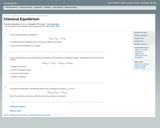
This worksheet assesses students' understanding of shifts in equilibrium.
- Subject:
- Science
- Material Type:
- Activity/Lab
- Provider:
- Chemistry 30
- Date Added:
- 10/11/2017

This worksheet assesses students' understanding of shifts in equilibrium.
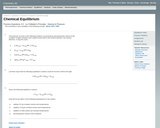
This worksheet assesses students' understanding of shifts in equilibrium.
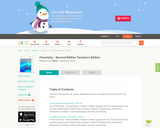
A work in progress, CK-12 Chemistry Teacher's Edition supports its Chemistry book covering: Matter; Atomic Structure; The Elements; Stoichiometry; Chemical Kinetics; Physical States of Matter; Thermodynamics; Nuclear and Organic Chemistry.

This is a culminating activity to be used after completion of a Thermochemistry unit, or later in the curriculum as review or evidence of concept retention. Students will create and label a heating curve, and explain what is happening on a molecular level using Livescribe Echo pens.
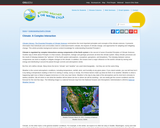
This article continues an examination of each of the seven essential principles of climate literacy on which the online magazine Beyond Weather and the Water Cycle is structured. Principle 2 covers the complex interactions among the components of the Earth system. The author discusses the scientific concepts underlying the interactions and expands the discussion with diagrams, photos, and online resources.

This question is addressed through a series of questions and answers, each providing related introductory information such as how climate change is studied, the history of Earth’s climate, and the effects of climate change on Earth’s geology and biology. The Climate Kids website is a NASA education resource featuring articles, videos, images and games focused on the science of climate change.
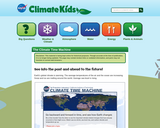
Use the imbedded sliding scale to observe changes in sea ice distribution, carbon emission levels and average global temperatures over time, as well as the effects of variations in sea level rise along coastal regions. This interactive is part of the Climate Kids website, a NASA education resource featuring articles, videos, images and games focused on the science of climate change.
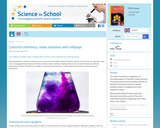
In this activity, students use a vivid colour-changing demonstration to illustrate a chain of redox reactions, whereby electrons are transferred between different compounds and ions.
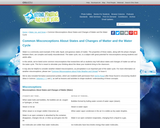
This article lists common misconceptions about states and changes of matter and the water cycle. It provides formative assessment probes and information about teaching for conceptual change.

In this classroom activity, students record the temperatures in and around a walk-in refrigerator or freezer to see how cold air behaves when it meets warmer air. The printable five-page handout includes a series of inquiry-based questions to get students thinking about how the temperature of air changes its density, detailed experiment directions and a worksheet that helps students use the experiment results to obtain insight into the wind patterns of Antarctica.

In this classroom activity, students use recycled materials to construct a polar creature that's ideally suited to life in Antarctica. They then document their creation with a field guide entry. The printable four-page handout includes a series of inquiry-based questions to get students thinking about what organisms need to survive in extreme environments, illustrated activity directions and a worksheet that includes brainstorming questions, areas for recording their answers, and directions for creating a field guide entry.
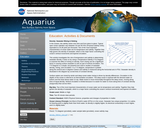
These two hands-on labs are about the role of temperature and salinity in governing the density of seawater, a major factor controlling the ocean's vertical movements and layered circulation. In the first activity students work in groups to determine the density of tap water and of tap water with salt, then compare the densities. The second activity investigates the role of temperature and salinity in determining seawater density. Students use a Temperature-Salinity (T-S) Diagram to examine the effect of mixing on density. A list of key concepts, essential questions, common preconceptions and more is included. These are part of the Aquarius Hands-on Laboratory Activities.

Learners will build an open spectrograph to calculate the angle the light is transmitted through a holographic diffraction grating. After finding the desired angles, the students will design their own spectrograph using the information learned. The activity is part of Project Spectra, a science and engineering program for middle-high school students, focusing on how light is used to explore the Solar System.

In this lesson, students will work in small groups to read and analyze a primary source using a set of questions designed to help them understand the writers' viewpoints. Students will then explain their findings to their classmates. Finally, each student will produce a written essay that explains how and why scientific understanding of the atom has changed over time.

The purpose of this resource is to use a land cover type map to make environmentally sound decisions.
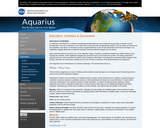
This is a hands-on lab activity about the chemical composition and conductivity of water. Working in groups, learners will: conduct an experiment involving the process of electrolysis, prepare an experiment to better understand the process of ion exchange, discuss and research the "softness" and "hardness" of water, and use the periodic table to identify elements and learn their characteristics. Background information, a glossary and more is included. Materials needed for each student group include a 9-volt battery, two electrodes (e.g. copper strips, or two #2 pencils sharpened at both ends), electrical wire and glass beakers or ceramic saucers. This activity is part of the Aquarius Hands-on Laboratory Activities.

A learning activity for the "Do You Know That Clouds Have Names?" book in the Elementary GLOBE series. Using information from the book and their observations, students construct a sky scene with trees and buildings as reference points on the ground and cloud types ordered by altitude in the sky. Students will describe clouds using their own vocabulary and will then correlate their descriptions with the standard classifications of cloud types used by the GLOBE Program. The purpose of the activity is to help students identify some of the characteristics of clouds and to enable students to observe clouds, describe them in a common vocabulary, and compare their descriptions with the official cloud names. Students will be able to identify cloud types using standard cloud classification names. They will know that the names used for the clouds are based on three factors: their shapes, the altitude at which they occur, and whether they are producing precipitation.

A learning activity for the Scoop on Soils book in the Elementary GLOBE Series. Each student will make predictions about the properties of various soil samples. Then they will examine several types of soils and record their observations. Next, they will learn about soil profiles and horizons by both examining a soil sample in a jar and by creating a soil profile flip chart. The purpose of the activity is to provide the opportunity for students to ask questions and make observations about soil and introduce students to the properties of soil and to the concept of soil profiles and horizons. After completing this activity, students will know about soil's different properties and about soil profiles. Students will know that soils have different properties including texture, color, and size. They will know that soil forms layers based on these properties.

Students will learn about magnification and how a magnifying lens works. They will examine a variety of different objects, first without a magnifier and then with a magnifier, and compare what they observe. They will practice observing details of these objects with magnifying lens. The purpose of this activity is for students to learn about observation skills and how tools can help people make observations, what "magnification" means, and to learn that scientists use tools, such as magnifying lenses, to examine objects. Students will be able to identify a magnifying glass and its purposes. They will be able to describe how the same object looks different when using the unaided eye versus a magnifying lens.

A learning activity for the Scoop on Soils book in the Elementary GLOBE Series. Students will make predictions about what they think they will find in a sample of soil. They will investigate the sample and sort out the various items they find. Next they will spend time outside observing one or more sites to see what they find in the soil. After recording and sharing their observations they will create their own stories about the things they found in the soil. The purpose of the activity is to learn about natural things commonly found in soil and how these things impact how the soil looks and feels as well as to introduce students to the concept of decomposition. After completing this activity, students will know about various things found in soil including rocks, critters, roots, and other organic material. They will also understand that animals and microorganisms aid in the decomposition process that contributes organic materials to soils.